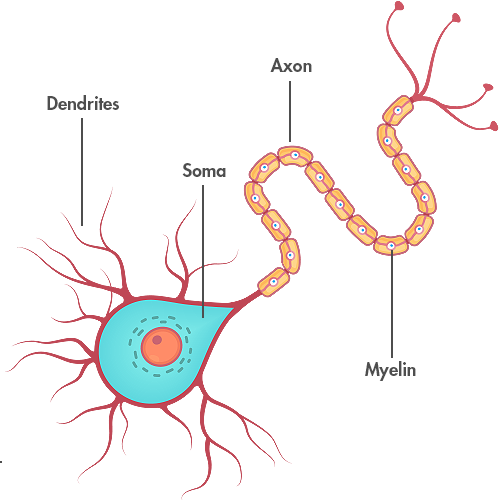<< Hide Menu
2.3 Overview of the Nervous System and the Neuron
3 min read•june 18, 2024
Dalia Savy
Haseung Jun
Megan Revello
Dalia Savy
Haseung Jun
Megan Revello
Vocabulary
|
|
|
Nervous System
The nervous system is our body’s speedy electrochemical messaging system. It is made up of both the peripheral and central nervous systems. The central nervous system (CNS) is composed of our brain🧠 and spinal cord🦴, while our peripheral nervous system (PNS) connects our sensory and motor neurons to the CNS.
CNS
As mentioned above, the CNS is composed of just the brain and spinal cord! The brain's neurons work in neural networks that send messages quickly.
A reflex is an automatic response often created by a signal neural pathway in our spinal cord. Reflexes are so quick and automatic because the message is received and responded to before our brain even has time to respond. The interneurons in the spinal cord enable this reflexive response.
The spinal cord is also a highway🛣️ connecting the peripheral nervous system and the brain.
PNS
The peripheral nervous system can be broken down further into the autonomic and somatic systems. The somatic nervous system is in charge of controlling voluntary movements of our skeletal muscles💪 - like covering your eye during an eye exam at the doctor. The autonomic nervous system then controls all automatic functions of our internal organs - like your heart beating❤️ and your lungs breathing. The automatic nervous system comes into play especially in fight-or-flight responses. It can increase your heart rate or blood pressure in such situations.
The autonomic nervous system can be broken down further into two other systems, the sympathetic and parasympathetic. The sympathetic nervous system is our arousal system. When you get nervous before an exam your heart may race, and your breathing may become more rapid - this is thanks to the autonomic nervous system, which prepares us for action🏃. On the other hand, the parasympathetic nervous system returns us to a calm and neutral state once the stimuli that triggered our original arousal has subsided.
💡Sympathetic = "Fight or Flight"
💡Parasympathetic = "Rest and Digest"

Image Courtesy of Lecturio

Image courtesy to Wikimedia Commons

Image courtesy to Wikimedia Commons
Neurons
Sensory neurons, sometimes referred to as afferent neurons, are what carry incoming sensory information into the brain and spinal cord (CNS). The sensory information is then processed by interneurons in the brain and spinal cord and then a message or response is carried back out through our motor, or efferent, neurons in our muscles and glands.
Sneak peek into the next key topic

Image Courtesy of CNS
How do signals occur? How does our brain know what to do? Basically, action potential must occur for a message to continue to travel down the axon of a neuron, which is the messenger. This only occurs if the neuron’s threshold has been met - meaning it has received enough stimulation🔋 from the original sending neuron. If this threshold is met, the action potential occurs and the message travels down the axon via a process of depolarization. If the threshold is not met, nothing happens. Neurons have an all-or-none response - they either fire or they don’t.
Once the message has passed through the axon, it reaches the terminal branches. The terminal branches of a neuron contain neurotransmitters which are then released. These neurotransmitters cross the synaptic gaps between neurons and are gathered in by dendrites of a new neuron, continuing the communication process📩.
The synapse is where two neurons meet and neurotransmitters are released into it. There is both an electrical synapse, which relays quick🐆 messages to another cell, and a chemical synapse, which sends messages slowly🦥 to another cell.

© 2024 Fiveable Inc. All rights reserved.